Modelling, Validation and Quantification of Climate and Other Sensitivities of Building Energy Model on 3D City Models †
Abstract
:1. Introduction
1.1. ISO Method Applied Without 3D City Models
1.2. ISO Method Applied on 3D City Models
1.3. Research Gaps
1.4. Objectives of the Paper
- implement the ISO method using the 3D city models to calculate the building heating and cooling energy needs on monthly basis (CityBEM model),
- develop an easy to use software architecture to carry out a quick and robust analysis,
- consider the buildings (geometry and attributes) of the 3D city models at a district or city scale and use publicly available datasets,
- perform a robust validation of the model,
- perform 3D visualization and analysis of results, and
- quantify the sensitivity of climate change and model parameters on monthly heating and cooling energy needs.
2. Methodological Approach
2.1. Overview
2.2. ISO 13790:2008 Monthly Calculation Method
- Definition of building boundaries for conditioned and unconditioned spaces,
- Identification of the zones (single vs. multi zones),
- Definition of the internal conditions for calculation of external climate, and other environmental data inputs (heat transfer losses, heat gain, etc.),
- Calculation of energy needs for heating and cooling, for each time step and building.
2.3. Required Input Data and Data Handling
2.4. Software Architecture
3. Implementation of the ISO Method
- Calculation of heat transfer coefficients by transmission () and ventilation ()
- Calculation of the total heat transfer () from transmission and ventilation, assuming the time step t of one month
- Calculation of heat flow coefficients from solar radiation () and internal sources ()
- Calculation of total heat gains () from the internal and solar heat gains, assuming the time step t of one month
- Calculation of the dynamic parameters: utilization factor for heat losses (cooling mode), utilization factor for heat gains (heating mode)
- Reduction factor for intermittent cooling () and heating ()
- Calculation of cooling and heating need:
- For the cooling mode:
- For the heating mode:where,
- Htr and Hve Heat transfer coefficients by transmission and ventilation in W/K
- Qint and Qsol Heat flow coefficients from internal sources and solar radiations in W
- Qht Total heat transfer (transmission and ventilation) in MJ
- Qgn Total heat gains (solar and internal gains) in MJ
- t Time step in month
- ηls Utilization factor for heat losses (no dimension)
- ηgn Utilization factor for heat gains (no dimension)
- aC, red Reduction factor for cooling (no dimension)
- aH, red Reduction factor for heating (no dimension)
- QC, nd Energy need for the continuous cooling mode in MJ
- QH, nd Energy need for the continuous heating mode in MJ
- QC, nd, interm Energy need for the intermittent cooling mode in MJ
- QH, nd, interm Energy need for the intermittent heating mode in MJ
4. Results
5. Validation of Model
5.1. Validation with Other Studies
5.2. Validation with ISO 13790 Reference
5.3. Validation with TRNSYS
5.3.1. Input Data
5.3.2. Assumptions
- Consideration of shading factors: In calculating solar gains in the CityBEM model, several factors such as, shading reduction factor for external obstacles (for the effective solar collection on the areas of surfaces), and form factor between the building element and the sky were considered. Nevertheless, the irradiation data obtained from PLANTING solar irradiance model already takes into account shading from external obstacles. Therefore, no shading reduction factor was considered in modelling solar gains in TRNSYS.
- Averaging internal heat flow: In the method proposed by TABULA project (http://episcope.eu/iee-project/tabula), the internal heat flow is equal to 3 W/m2 for every building type. In the example of ISO (Annex J), it is 20 W/m2 from 8 a.m. to 6 p.m. So, the time average internal heat flow of 8 W/m2 (≈ 0.416 × 20) was considered in both approaches. This value refers to specific heat gains averaged for a day.
- Introducing time reduction factors: Continuous cooling or heating is unrealistic. In order to make a good comparison, the scheduling factors in TRNSYS and in the CityBEM model were defined appropriately by introducing a time reduction factor.
5.3.3. Validation Results
6. Sensitivity Analyses
6.1. Parameter Sensitivity
6.2. Derivation of Sensitivity Index
6.3. Climate Sensitivity
6.4. Discussion
7. Conclusions
Author Contributions
Funding
Acknowledgments
Conflicts of Interest
Appendix A. Results of Parameter Sensitivity Analyses
| Parameters Values/Month | Monthly Heating Energy Needs (kWh/m²) | Monthly Cooling Energy Needs (kWh/m²) | Total Annual Heating Needs | Total Annual Cooling Needs | ||||||||||||||||||||||
| Jan | Feb | Mar | Apr | May | Jun | Jul | Aug | Sep | Oct | Nov | Dec | Jan | Feb | Mar | Apr | May | Jun | Jul | Aug | Sep | Oct | Nov | Dec | |||
| vent&inf_coef 0.5 | 11.1 | 8.5 | 5.2 | 1.5 | 0.2 | 0 | 0 | 0 | 0.2 | 2 | 7.1 | 10.5 | 0 | 0.1 | 0.1 | 0.3 | 0.6 | 1.2 | 1.8 | 1.4 | 0.5 | 0.2 | 0 | 0 | 46.3 | 6.2 |
| vent&inf_coef 0.75 | 12.8 | 9.9 | 6.3 | 2 | 0.3 | 0 | 0 | 0 | 0.4 | 2.5 | 8.4 | 12.2 | 0.1 | 0.1 | 0.1 | 0.2 | 0.5 | 1.1 | 1.6 | 1.3 | 0.4 | 0.2 | 0.1 | 0 | 54.8 | 5.7 |
| vent&inf_coef 1 | 14.6 | 11.4 | 7.3 | 2.4 | 0.4 | 0 | 0 | 0 | 0.5 | 2.9 | 9.7 | 13.8 | 0 | 0 | 0.1 | 0.2 | 0.5 | 1 | 1.5 | 1.2 | 0.4 | 0.2 | 0.1 | 0 | 63 | 5.2 |
| vent&inf_coef 1.25 | 16.4 | 12.8 | 8.3 | 2.8 | 0.6 | 0 | 0 | 0 | 0.7 | 3.4 | 10.9 | 15.5 | 0 | 0.1 | 0.1 | 0.2 | 0.5 | 0.9 | 1.4 | 1.1 | 0.4 | 0.2 | 0.1 | 0 | 71.4 | 5 |
| vent&inf_coef 1.5 | 18.1 | 14.2 | 9.4 | 3.3 | 0.7 | 0 | 0 | 0 | 0.8 | 4 | 12.2 | 17.2 | 0.1 | 0.1 | 0.1 | 0.2 | 0.4 | 0.9 | 1.3 | 1 | 0.3 | 0.1 | 0 | 0 | 79.9 | 4.5 |
| int_gain_coef 0.5 | 19.5 | 15.7 | 11.4 | 4.9 | 0.8 | 0 | 0 | 0 | 1 | 6.4 | 14.1 | 18.7 | 0 | 0 | 0 | 0.1 | 0.1 | 0.3 | 0.4 | 0.3 | 0.1 | 0 | 0 | 0 | 92.5 | 1.3 |
| int_gain_coef 0.75 | 17 | 13.4 | 9.2 | 3.3 | 0.6 | 0 | 0 | 0 | 0.7 | 4.5 | 11.7 | 16.2 | 0 | 0 | 0 | 0.1 | 0.3 | 0.6 | 0.9 | 0.7 | 0.2 | 0.1 | 0 | 0 | 76.6 | 2.9 |
| int_gain_coef 1 | 14.6 | 11.4 | 7.3 | 2.4 | 0.4 | 0 | 0 | 0 | 0.5 | 2.9 | 9.7 | 13.8 | 0 | 0 | 0.1 | 0.2 | 0.5 | 1 | 1.5 | 1.2 | 0.4 | 0.2 | 0.1 | 0 | 63 | 5.2 |
| int_gain_coef 1.25 | 12.5 | 9.6 | 5.6 | 2 | 0.3 | 0 | 0 | 0 | 0.4 | 2.3 | 7.8 | 11.7 | 0.1 | 0.1 | 0.2 | 0.4 | 0.8 | 1.5 | 2.2 | 1.8 | 0.6 | 0.3 | 0.1 | 0.1 | 52.2 | 8.2 |
| int_gain_coef 1.5 | 10.5 | 7.9 | 4.2 | 1.7 | 0.2 | 0 | 0 | 0 | 0.3 | 2 | 6.2 | 9.8 | 0.2 | 0.2 | 0.3 | 0.6 | 1.2 | 2.2 | 3 | 2.5 | 1 | 0.5 | 0.2 | 0.2 | 42.8 | 12.1 |
| VolumeToAf 0.28 => Room height=3m | 17.3 | 13.5 | 8.7 | 3 | 0.6 | 0 | 0 | 0 | 0.7 | 3.7 | 11.6 | 16.4 | 0 | 0.1 | 0.1 | 0.2 | 0.5 | 1 | 1.4 | 1.1 | 0.4 | 0.2 | 0.1 | 0 | 75.5 | 5.1 |
| VolumeToAf 0.3 => Room height=2.8m | 15.9 | 12.4 | 8 | 2.7 | 0.5 | 0 | 0 | 0 | 0.6 | 3.3 | 10.5 | 15.1 | 0 | 0.1 | 0.1 | 0.2 | 0.5 | 1 | 1.5 | 1.1 | 0.4 | 0.2 | 0.1 | 0 | 69 | 5.2 |
| VolumeToAf 0.32 => Room height=2.6m | 14.6 | 11.4 | 7.3 | 2.4 | 0.4 | 0 | 0 | 0 | 0.5 | 2.9 | 9.7 | 13.8 | 0 | 0 | 0.1 | 0.2 | 0.5 | 1 | 1.5 | 1.2 | 0.4 | 0.2 | 0.1 | 0 | 63 | 5.2 |
| VolumeToAf 0.35 => Room height=2.4m | 13 | 10.1 | 6.4 | 2 | 0.3 | 0 | 0 | 0 | 0.4 | 2.5 | 8.5 | 12.3 | 0 | 0.1 | 0.1 | 0.2 | 0.5 | 1 | 1.6 | 1.2 | 0.4 | 0.2 | 0 | 0 | 55.5 | 5.3 |
| VolumeToAf 0.38 => Room height=2.2m | 11.6 | 9 | 5.7 | 1.7 | 0.2 | 0 | 0 | 0 | 0.3 | 2.2 | 7.5 | 11 | 0 | 0.1 | 0.1 | 0.2 | 0.5 | 1.1 | 1.6 | 1.3 | 0.4 | 0.2 | 0.1 | 0 | 49.2 | 5.6 |
| temp_cooling 18°C | 14.6 | 11.4 | 7.3 | 2.4 | 0.4 | 0 | 0 | 0 | 0.5 | 2.9 | 9.7 | 13.8 | 0.1 | 0.1 | 0.3 | 0.9 | 3.4 | 9 | 11.6 | 10.4 | 2.8 | 0.6 | 0.2 | 0.1 | 63 | 39.5 |
| temp_cooling 20°C | 14.6 | 11.4 | 7.3 | 2.4 | 0.4 | 0 | 0 | 0 | 0.5 | 2.9 | 9.7 | 13.8 | 0.1 | 0.1 | 0.2 | 0.6 | 2 | 4.5 | 8.8 | 7.5 | 1.6 | 0.4 | 0.1 | 0.1 | 63 | 26 |
| temp_cooling 22°C | 14.6 | 11.4 | 7.3 | 2.4 | 0.4 | 0 | 0 | 0 | 0.5 | 2.9 | 9.7 | 13.8 | 0.1 | 0.1 | 0.2 | 0.4 | 1.2 | 2.7 | 4.2 | 3.4 | 0.9 | 0.3 | 0.1 | 0.1 | 63 | 13.7 |
| temp_cooling 24°C | 14.6 | 11.4 | 7.3 | 2.4 | 0.4 | 0 | 0 | 0 | 0.5 | 2.9 | 9.7 | 13.8 | 0.1 | 0.1 | 0.1 | 0.3 | 0.7 | 1.6 | 2.5 | 2 | 0.6 | 0.2 | 0.1 | 0.1 | 63 | 8.4 |
| temp_cooling 26°C | 14.6 | 11.4 | 7.3 | 2.4 | 0.4 | 0 | 0 | 0 | 0.5 | 2.9 | 9.7 | 13.8 | 0 | 0 | 0.1 | 0.2 | 0.5 | 1 | 1.5 | 1.2 | 0.4 | 0.2 | 0.1 | 0 | 63 | 5.2 |
| temp_heating 18°C | 12 | 9 | 5 | 1.4 | 0.1 | 0 | 0 | 0 | 0.1 | 1.7 | 7.2 | 11.2 | 0 | 0 | 0.1 | 0.2 | 0.5 | 1 | 1.5 | 1.2 | 0.4 | 0.2 | 0.1 | 0 | 47.7 | 5.2 |
| temp_heating 20°C | 14.6 | 11.4 | 7.3 | 2.4 | 0.4 | 0 | 0 | 0 | 0.5 | 2.9 | 9.7 | 13.8 | 0 | 0 | 0.1 | 0.2 | 0.5 | 1 | 1.5 | 1.2 | 0.4 | 0.2 | 0.1 | 0 | 63 | 5.2 |
| temp_heating 22°C | 17.3 | 13.8 | 9.8 | 3.9 | 1.2 | 0.1 | 0 | 0 | 1.3 | 5.1 | 12.2 | 16.5 | 0 | 0 | 0.1 | 0.2 | 0.5 | 1 | 1.5 | 1.2 | 0.4 | 0.2 | 0.1 | 0 | 81.2 | 5.2 |
| temp_heating 24°C | 20 | 16.2 | 12.3 | 6.1 | 2.1 | 0.6 | 0.2 | 0.4 | 2.2 | 7.5 | 14.8 | 19.3 | 0 | 0 | 0.1 | 0.2 | 0.5 | 1 | 1.5 | 1.2 | 0.4 | 0.2 | 0.1 | 0 | 101.7 | 5.2 |
| temp_heating 26°C | 22.8 | 18.7 | 15 | 8.4 | 3.3 | 1.4 | 0.8 | 1.1 | 3.8 | 10 | 17.4 | 22 | 0 | 0 | 0.1 | 0.2 | 0.5 | 1 | 1.5 | 1.2 | 0.4 | 0.2 | 0.1 | 0 | 124.7 | 5.2 |
| u_values 0.5 | 9.7 | 7.5 | 4.6 | 1.3 | 0.1 | 0 | 0 | 0 | 0.2 | 1.7 | 6.2 | 9.1 | 0 | 0.1 | 0.1 | 0.2 | 0.5 | 1.1 | 1.7 | 1.3 | 0.4 | 0.2 | 0.1 | 0 | 40.4 | 5.7 |
| u_values 0.75 | 12.2 | 9.4 | 6 | 1.8 | 0.3 | 0 | 0 | 0 | 0.3 | 2.3 | 7.9 | 11.5 | 0 | 0 | 0.1 | 0.2 | 0.5 | 1 | 1.6 | 1.2 | 0.4 | 0.2 | 0.1 | 0 | 51.7 | 5.3 |
| u_values 1 | 14.6 | 11.4 | 7.3 | 2.4 | 0.4 | 0 | 0 | 0 | 0.5 | 2.9 | 9.7 | 13.8 | 0 | 0 | 0.1 | 0.2 | 0.5 | 1 | 1.5 | 1.2 | 0.4 | 0.2 | 0.1 | 0 | 63 | 5.2 |
| u_values 1.25 | 17.1 | 13.3 | 8.6 | 3 | 0.6 | 0 | 0 | 0 | 0.7 | 3.5 | 11.3 | 16.2 | 0.1 | 0 | 0.1 | 0.2 | 0.5 | 1 | 1.5 | 1.1 | 0.4 | 0.2 | 0.1 | 0 | 74.3 | 5.2 |
| u_values 1.5 | 19.5 | 15.2 | 9.9 | 3.5 | 0.8 | 0 | 0 | 0 | 0.9 | 4.1 | 13 | 18.5 | 0 | 0.1 | 0.1 | 0.3 | 0.5 | 1 | 1.5 | 1.1 | 0.4 | 0.2 | 0.1 | 0 | 85.4 | 5.3 |
References
- Swan, L.G.; Ugursal, V.I. Modeling of end-use energy consumption in the residential sector: A review of modeling techniques. Renew. Sustain. Energy Rev. 2009, 13, 1819–1835. [Google Scholar] [CrossRef]
- Nouvel, R.; Mastrucci, A.; Leopold, U.; Baume, O.; Coors, V.; Eicker, U. Combining gis-based statistical and engineering urban heat consumption models: Towards a new framework for multi-scale policy support. Energy Build. 2015, 107, 204–212. [Google Scholar] [CrossRef]
- Bahu, J.-M.; Koch, A.; Kremers, E.; Murshed, S.M. Towards a 3D spatial urban energy modelling approach. Int. J. 3-D Inf. Model. (IJ3DIM) 2014, 3, 1–16. [Google Scholar] [CrossRef]
- Koch, E.A. Continuous Simulation for Urban energy Planning Based on a Non-Linear Data-Driven Modelling Approach; Karlsruher Instituts für Technologie: Karlsruhe, Germany, 2016. [Google Scholar]
- Chalal, M.L.; Benachir, M.; White, M.; Shrahily, R. Energy planning and forecasting approaches for supporting physical improvement strategies in the building sector: A review. Renew. Sustain. Energy Rev. 2016, 64, 761–776. [Google Scholar] [CrossRef] [Green Version]
- Reinhart, C.F.; Davila, C.C. Urban building energy modeling–A review of a nascent field. Build. Environ. 2016, 97, 196–202. [Google Scholar] [CrossRef]
- Mendes, G.; Ioakimidis, C.; Ferrão, P. On the planning and analysis of Integrated Community Energy Systems: A review and survey of available tools. Renew. Sustain. Energy Rev. 2011, 15, 4836–4854. [Google Scholar] [CrossRef]
- ISO. Energy performance of buildings—Calculation of energy use for space heating and cooling. In ISO 13790:2008(E); International Organization for Standardization: Geneva, Switzerland, 2008; p. 162. [Google Scholar]
- Attia, S.; Ana Muresan, A. Romanian Standards for Energy Performance in Buildings Translation of the Romanian Standards for Energy Performance in Buildings; Sustainable Buildings Design Lab: Liege, Belgium, 2015; p. 61. [Google Scholar]
- Kwak, H.-J.; Jo, J.-H.; Suh, S.-J. Evaluation of the reference numerical parameters of the monthly method in ISO 13790 considering s/v ratio. Sustainability 2015, 7, 767–781. [Google Scholar] [CrossRef]
- Vollaro, R.D.L.; Guattari, C.; Evangelisti, L.; Battista, G.; Carnielo, E.; Gori, P. Building energy performance analysis: A case study. Energy Build. 2014, 87, 87–94. [Google Scholar] [CrossRef]
- Kim, Y.-J.; Yoon, S.-H.; Park, C.-S. Stochastic comparison between simplified energy calculation and dynamic simulation. Energy Build. 2013, 64, 332–342. [Google Scholar] [CrossRef]
- Kristensen, M.H.; Petersen, S. Choosing the appropriate sensitivity analysis method for building energy model-based investigations. Energy Build. 2016, 130, 166–176. [Google Scholar] [CrossRef]
- Kokogiannakis, G.; Strachan, P.; Clarke, J. Comparison of the simplified methods of the ISO 13790 standard and detailed modelling programs in a regulatory context. J. Build. Perform. Simul. 2008, 1, 209–219. [Google Scholar] [CrossRef] [Green Version]
- Corrado, V.; Fabrizio, E. Assessment of building cooling energy need through a quasi-steady state model: Simplified correlation for gain-loss mismatch. Energy Build. 2007, 39, 569–579. [Google Scholar] [CrossRef]
- Zangheri, P.; Armani, R.; Pietrobon, M.; Pagliano, L.; Boneta, M.F.; Müller, A. Heating and Cooling Energy Demand and Loads for Building Types in Different Countries of the EU; Report in the Frame of the EU Project ENTRANZE; Politecnico di Milano: Milan, Italy, 2014. [Google Scholar]
- Sirén, K.; Hasan, A. Comparison of Two Calculation Methods Used to Estimate Cooling Energy Demand and Indoor Summer Temperatures. In Proceedings of the Clima 2007 Well-Being Indoors, Helsinki, Finland, 10–14 June 2007. [Google Scholar]
- Vartieres, A.; Berescu, A.; Damian, A. Energy demand for cooling an office building. In Proceedings of the 11th International Conference on Environment, Ecosystems and Development, Brasov, Romania, 1–3 June 2013; pp. 132–135. [Google Scholar]
- Petersen, S.; Svendsen, S. Method and simulation program informed decisions in the early stages of building design. Energy Build. 2010, 42, 1113–1119. [Google Scholar] [CrossRef]
- Sun, Y. Sensitivity analysis of macro-parameters in the system design of net zero energy building. Energy Build. 2015, 86, 464–477. [Google Scholar] [CrossRef]
- Heiselberg, P.; Brohus, H.; Hesselholt, A.; Rasmussen, H.; Seinre, E.; Thomas, S. Application of sensitivity analysis in design of sustainable buildings. Renew. Energy 2009, 34, 2030–2036. [Google Scholar] [CrossRef] [Green Version]
- Spitz, C.; Mora, L.; Wurtz, E.; Jay, A. Practical application of uncertainty analysis and sensitivity analysis on an experimental house. Energy Build. 2012, 55, 459–470. [Google Scholar] [CrossRef]
- Lomas, K.J.; Eppel, H. Sensitivity analysis techniques for building thermal simulation programs. Energy Build. 1992, 19, 21–44. [Google Scholar] [CrossRef]
- OGC. OGC City Geography Markup Language (Citygml) Encoding Standard 2.0.0; Open Geospatial Consortium: Wayland, MA, USA, 2012; p. 344. [Google Scholar]
- Biljecki, F.; Stoter, J.; Ledoux, H.; Zlatanova, S.; Çöltekin, A. Applications of 3D city models: State of the art review. ISPRS Int. J. Geo-Inf. 2015, 4, 2842–2889. [Google Scholar] [CrossRef] [Green Version]
- Eicker, U.; Nouvel, R.; Schulte, C.; Schumacher, J.; Coors, V. 3D Stadtmodelle für Die Wärmebedarfberechnung. In Proceedings of the Fourth German-Austrian IBPSA Conference, Berlin, Germany, 26–28 September 2012. [Google Scholar]
- Nouvel, R.; Schulte, C.; Eicker, U.; Pietruschka, D.; Coors, V. Citygml-based 3D city model for energy diagnostics and urban energy policy supports. In Proceedings of the 13th Conference of International Building Performance Simulation Association, Chambéry, France, 26–28 August 2013. [Google Scholar]
- Agugiaro, G. Energy planning tools and CityGML-based 3D virtual city models: Experiences from Trento (Italy). Appl. Geomat. 2016, 8, 41–56. [Google Scholar] [CrossRef]
- Meteonorm. Meteonorm Global Meteorological Database—Version 7 Software and Data for Engineers, Planners and Education, 7th ed.; Meteotest AG: Bern, Switzerland, 2018. [Google Scholar]
- Murshed, S.M.; Lindsay, A.; Picard, S.; Simons, A. PLANTING: Computing high spatio-temporal resolutions of photovoltaic potential of 3D city models. In Geospatial Technologies for All, Lecture Notes in Geoinformation and Cartography; Mansourian, A., Pilesjö, P., Harrie, L., van Lammere, R., Eds.; Springer International Publishing AG: Cham, Switzerland, 2018. [Google Scholar]
- Murshed, S.M.; Simons, A.; Lindsay, A.; Picard, S.; De Pin, C. Evaluation of Two Solar Radiation Algorithms on 3D City Models for Calculating Photovoltaic Potential. In Proceedings of the 4th International Conference on Geographical Information Systems Theory, Applications and Management (GISTAM 2018), Funchal, Madeira, Portugal, 17–19 March 2018; SCITEPRESS—Science and Technology Publications, Lda: Setúbal, Portugal, 2018. [Google Scholar]
- Lam, J.C.; Hui, S.C. Sensitivity analysis of energy performance of office buildings. Build. Environ. 1996, 31, 27–39. [Google Scholar] [CrossRef]
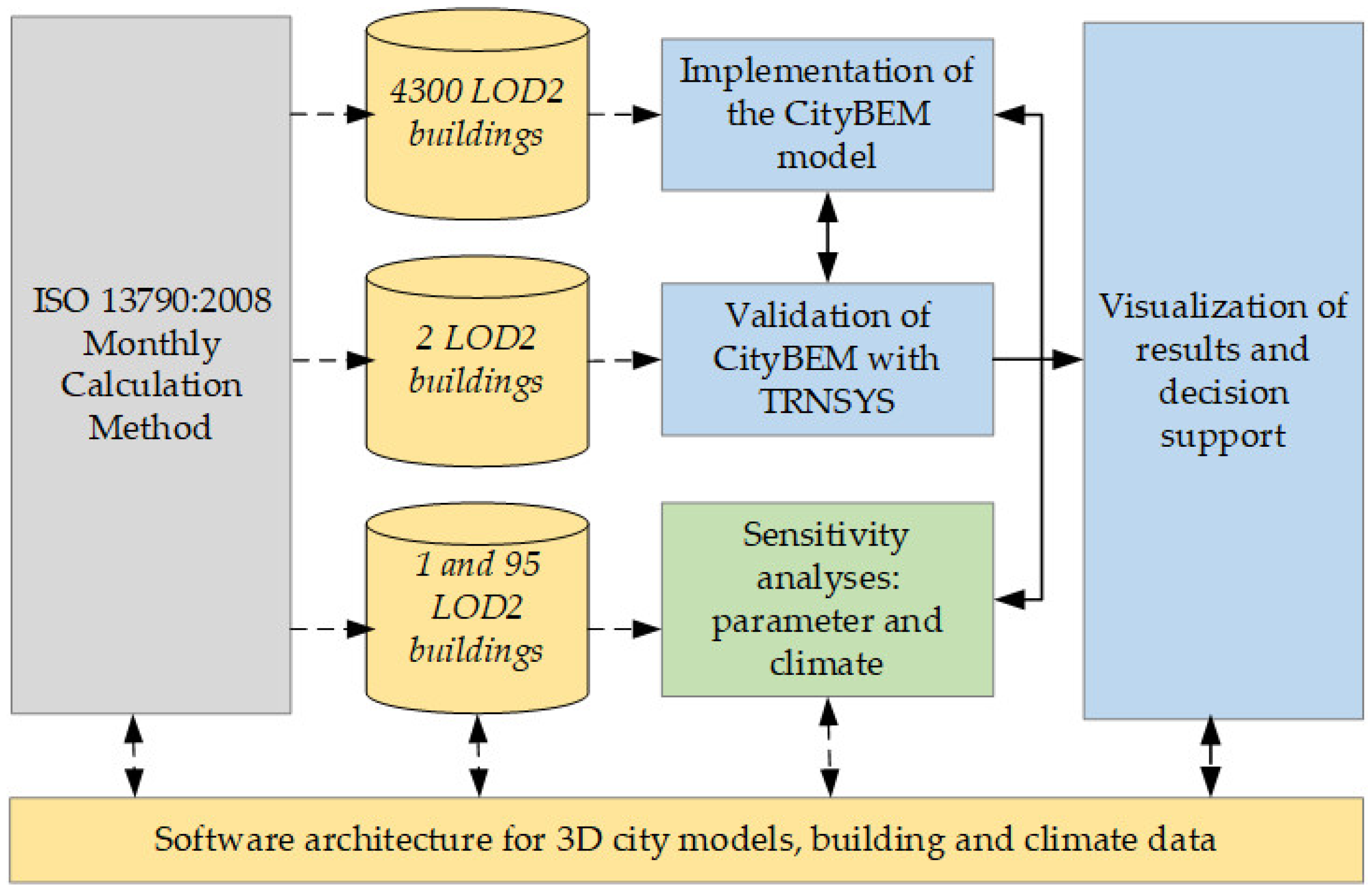
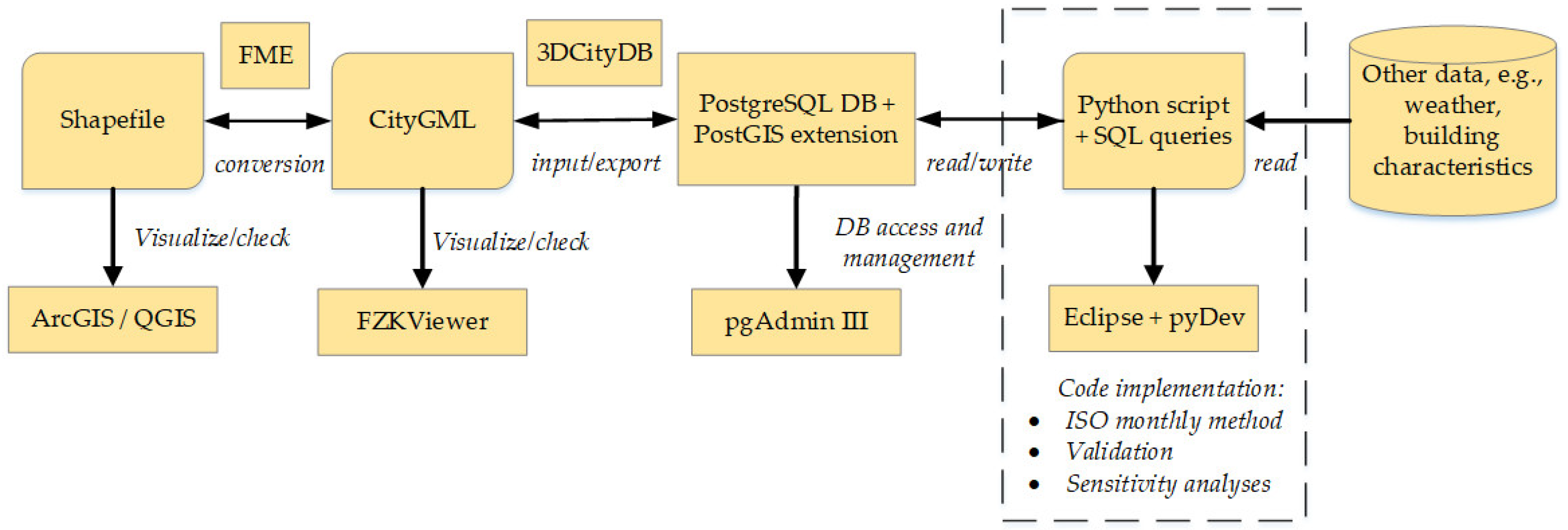


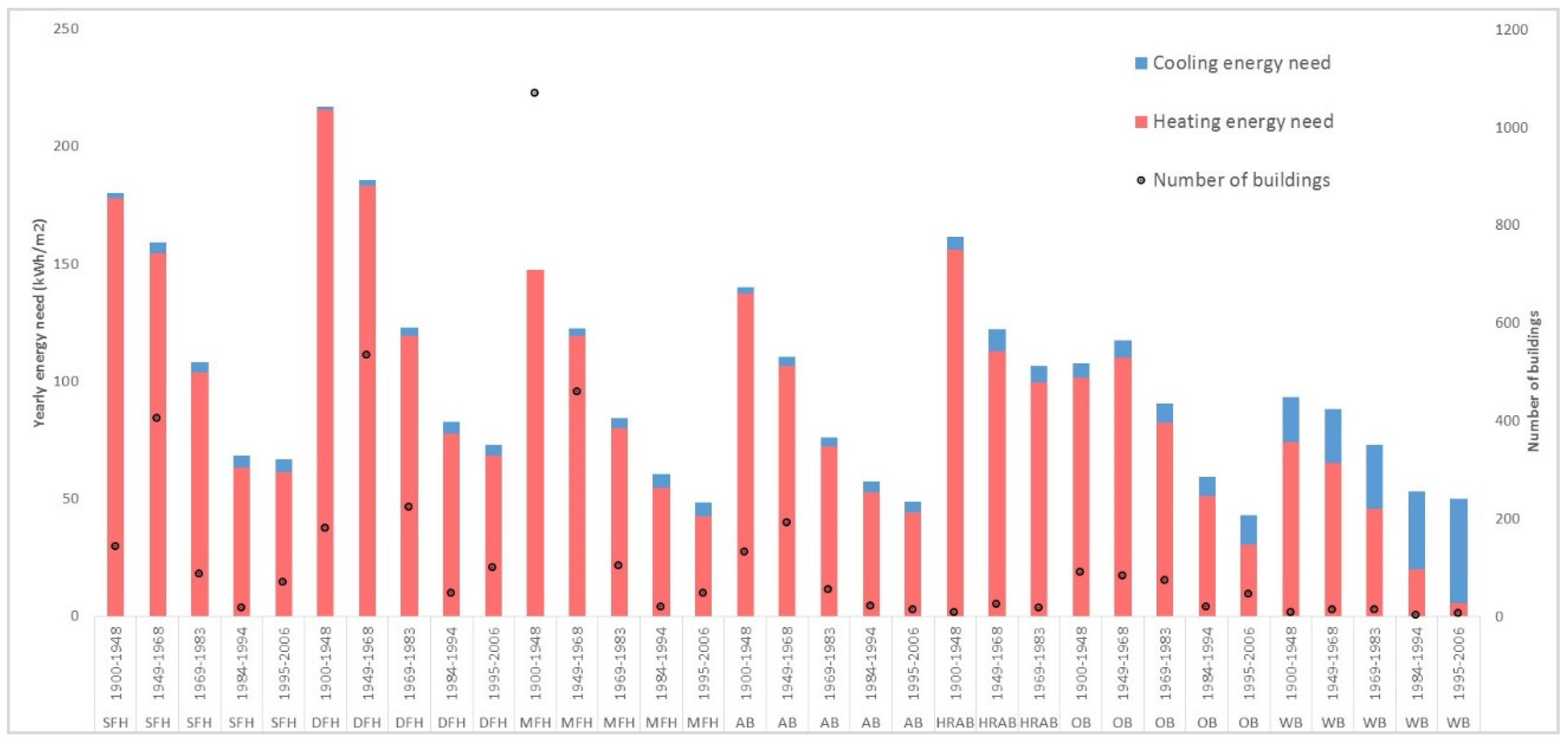





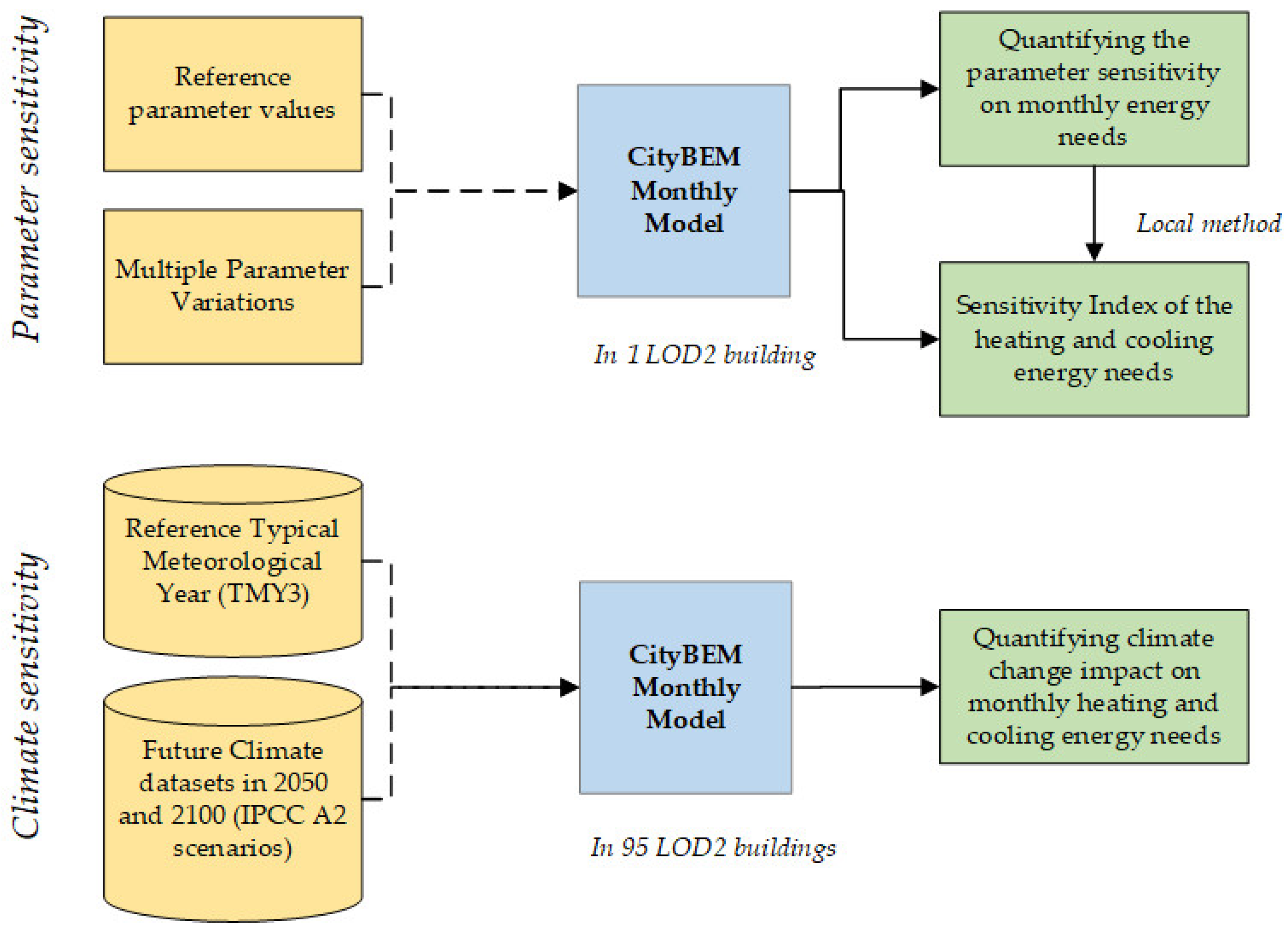


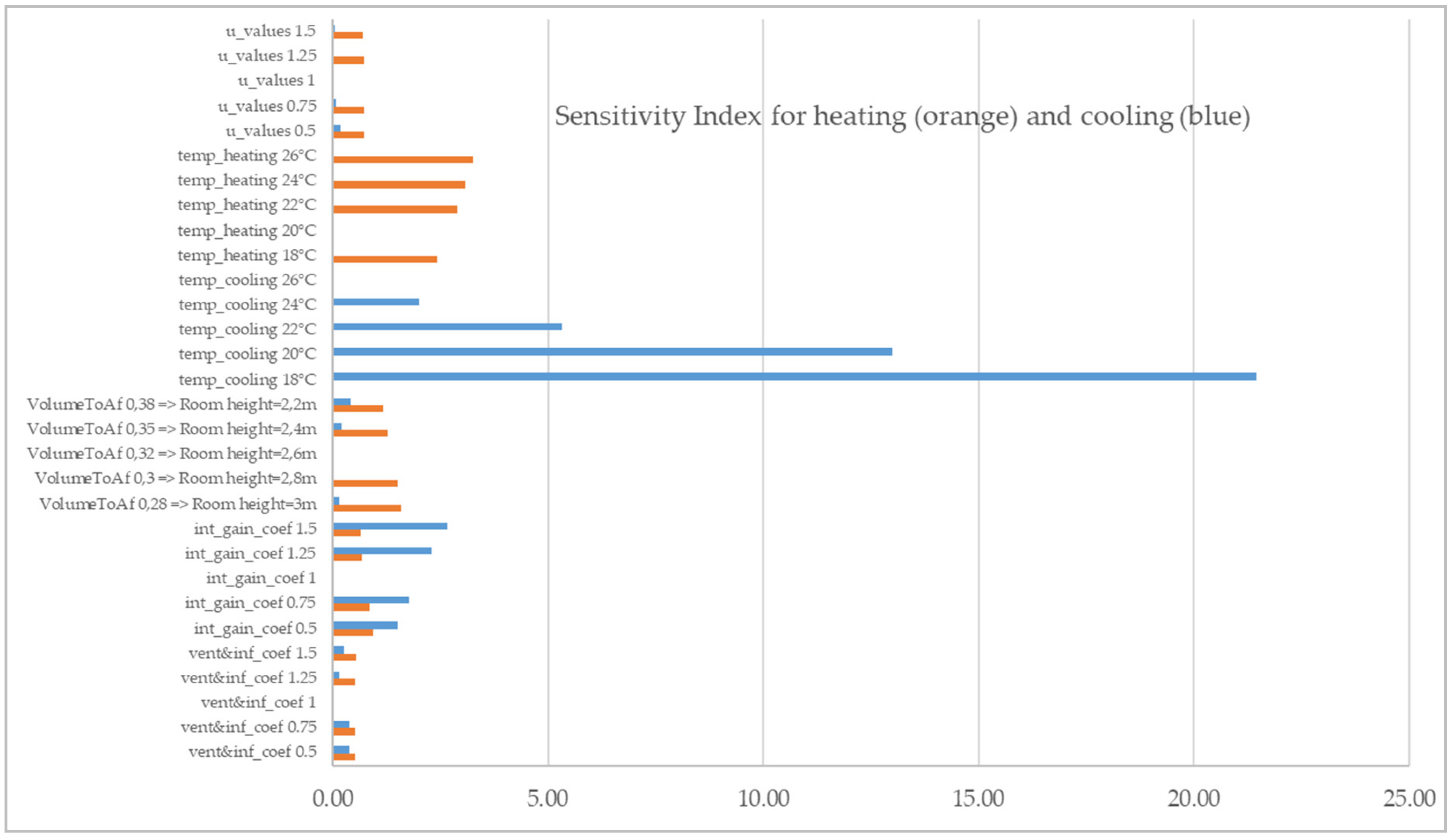




| Input data | Unit | Source |
|---|---|---|
| Building Geometry | ||
| Wall North | m2 | CityGML data |
| Wall South | m2 | CityGML data |
| Wall East | m2 | CityGML data |
| Wall West | m2 | CityGML data |
| Volume | m3 | CityGML data |
| Floor area/conditioned used area | m2 | Calculated from EnEV 2015 and volume |
| Effective mass area | m2 | Calculated from the floor area [8] pp. 66–68 |
| Building Typology | ||
| Windows North | % | District Energy Concept Advisor 1 |
| Windows South | % | District Energy Concept Advisor |
| Windows East | % | District Energy Concept Advisor |
| Windows West | % | District Energy Concept Advisor |
| U-value wall | W/m2K | IWU 2 |
| U-value roof | W/m2K | IWU |
| U-value ground | W/m2K | IWU |
| U-value windows | W/m2K | IWU |
| g-value windows | - | IWU |
| Thermal bridges | W/m2K | IWU |
| Infiltration | 1/h | IWU |
| Ventilation | 1/h | IWU |
| Internal heat from occupants | W/m2 | IWU |
| Internal heat from appliances | W/m2 | IWU |
| Internal heat from lighting | W/m2 | IWU |
| Climate Conditions | ||
| Monthly temperature of the external environment | °C | Meteonorm (TMY3) |
| Monthly wind speed | m/s | Meteonorm (TMY3) |
| Monthly solar irradiance | W/m2 | Solar radiation model |
| Parameters | Residential Building | Office Building | |
|---|---|---|---|
| Window area (m2) | North | 4.47 (4.9%) | 9.27 (10.16%) |
| South | 11.19 (12.25%) | 8.34 (9.13%) | |
| East | 5.54 (6.74%) | 10.08 (12.25%) | |
| West | 5.54 (6.74%) | 11.39 (13.85%) | |
| U values (W/m2k) | Wall | 0.6 | 1.5 |
| Roof | 0.4 | 1 | |
| Floor | 0.6 | 1.2 | |
| Window | 2.7 | 2.9 | |
| G value (-) | 0.75 | 0.75 | |
| Thermal bridges (W/m2K) | 0.1 | 0.15 | |
| Infiltration (h−1) | 0.2 | 0.2 | |
| Ventilation (h−1) | 0.5 | 0.5 | |
| Internal heat gains (W/m2) | 19.4 | 24.7 | |
| Set-point temperature (°C) | Heating | 20 | 20 |
| Cooling | 26 | 26 | |
| Input Parameters for Sensitivity Analyses | Reference Values | Range of Sensitive Values Chosen |
|---|---|---|
| U-values of ground, roof, wall and window (W/m2K) | 1 | 0.5, 0.75, 1.25, 1.5 |
| Volume to floor area ratio (1/m) | 0.32 (having room height 2.6 m) | 0.28, 0.30, 0.35, 0.38 (having room height 3.0 m, 2.8 m, 2.4 m, 2.2 m respectively) |
| Ventilation and infiltration coefficient (1/h) | 1 | 0.5, 0.75, 1.25, 1.5 |
| Internal heat gain (W/m2) | 1 | 0.5, 0.75, 1.25, 1.5 |
| Cooling set point temperature (°C) | 26 | 18, 20, 22, 24, 26 |
| Heating set point temperature (°C) | 20 | 18, 20, 22, 24, 26 |
© 2018 by the authors. Licensee MDPI, Basel, Switzerland. This article is an open access article distributed under the terms and conditions of the Creative Commons Attribution (CC BY) license (http://creativecommons.org/licenses/by/4.0/).
Share and Cite
Murshed, S.M.; Picard, S.; Koch, A. Modelling, Validation and Quantification of Climate and Other Sensitivities of Building Energy Model on 3D City Models. ISPRS Int. J. Geo-Inf. 2018, 7, 447. https://0-doi-org.brum.beds.ac.uk/10.3390/ijgi7110447
Murshed SM, Picard S, Koch A. Modelling, Validation and Quantification of Climate and Other Sensitivities of Building Energy Model on 3D City Models. ISPRS International Journal of Geo-Information. 2018; 7(11):447. https://0-doi-org.brum.beds.ac.uk/10.3390/ijgi7110447
Chicago/Turabian StyleMurshed, Syed Monjur, Solène Picard, and Andreas Koch. 2018. "Modelling, Validation and Quantification of Climate and Other Sensitivities of Building Energy Model on 3D City Models" ISPRS International Journal of Geo-Information 7, no. 11: 447. https://0-doi-org.brum.beds.ac.uk/10.3390/ijgi7110447





